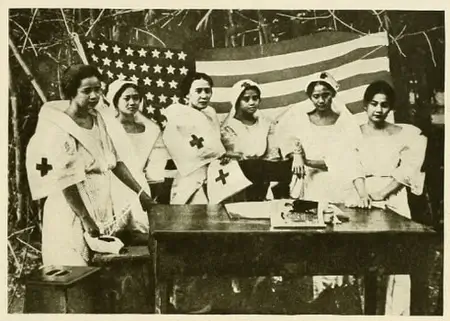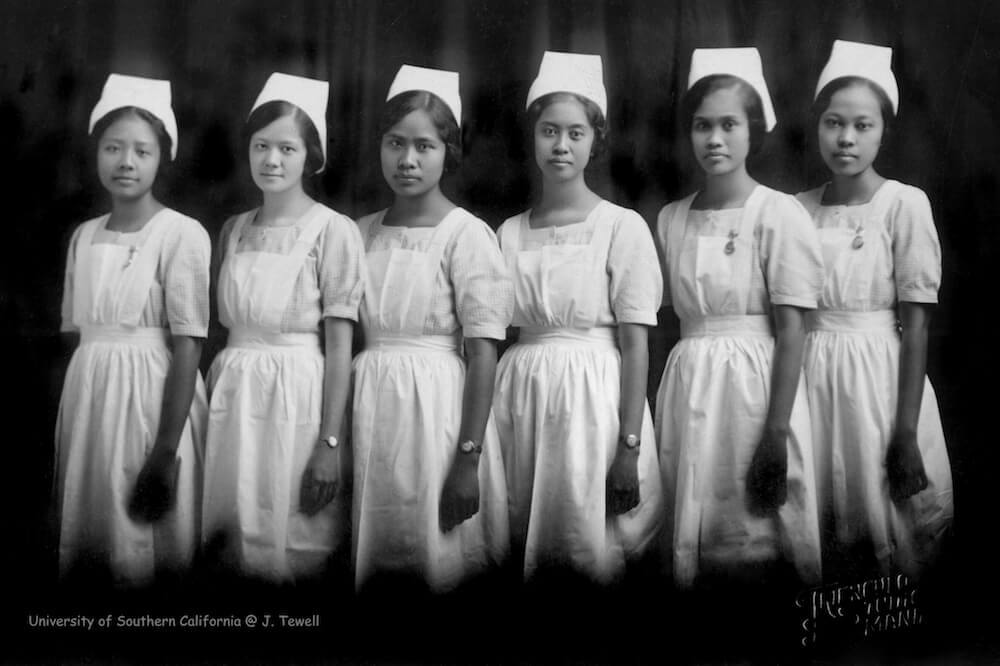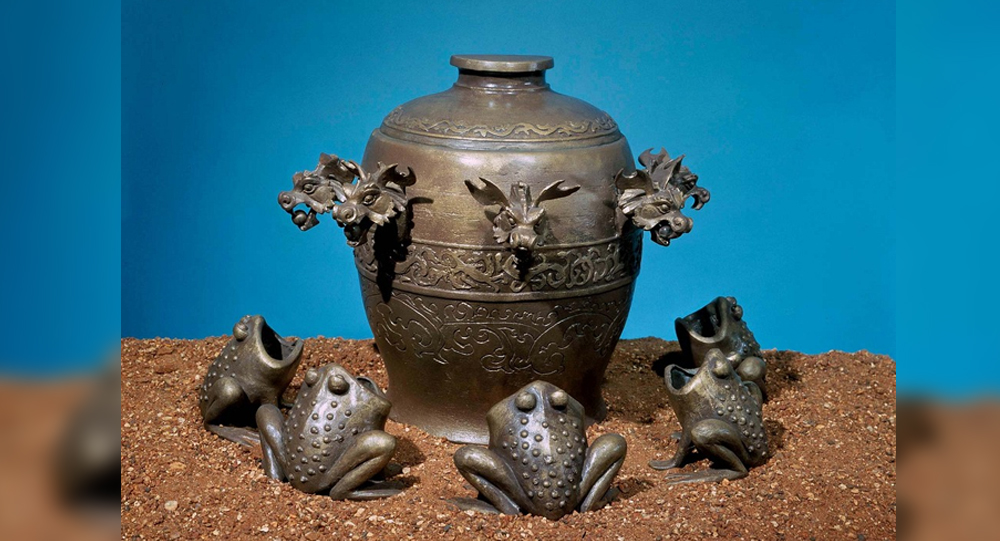
After WWII, the United States began to experience nursing shortages, and they began to look abroad for nurses. The Philippines became an obvious and important source of nurses, in part because they were trained in the United States.
This expansion of Filipino nurses to the United States is not new, and it stems from the Philippines’ long history of US colonialism.
Nurses from the Philippines are now employed all over the world.
Catherine Choy, an ethnic studies professor at the University of California Berkeley, describes how the US colonial regime began recruiting Filipino nurses in her book “Empire of Care.”

She claims that the demand for Filipino nurses in the United States stems from the Philippines’ status as a US colony, where the colonial regime instituted an Americanized education system, which included nurse training.
In addition, the United States established the pensionados program in the Philippines, which functions similarly to a study abroad program.
Many Filipino nurses retired; some went on to work elsewhere, while others returned to the Philippines between 1903 and 1940 to help establish nursing schools.
According to Choy, another wave of nursing shortages erupted in the 1960s as a result of the growing women’s movement of the time.
“However, as the movement grew, opportunities in a variety of professions arose, making it difficult to recruit American women into nursing — especially because nursing is a physically demanding profession.”
As a result, women in the United States had more professional opportunities in a variety of fields. “Traditionally, they were often relegated as professionals to professions that were considered appropriate for women, such as nursing, education, or social work,” she says.
Marcos’ survival strategy

Because of the constant demand for nurses, Filipino nurses have continued to migrate to the United States.
This was enhanced even further in the early 1970s, when then-dictator Ferdinand Marcos began to encourage labor migration from the Philippines.
Due to the country’s stagnant economy, there were an increasing number of unemployed young men, and Marcos saw this as an opportunity to send them abroad for work while establishing a system that could easily regulate and support labor outflows.
Marcos also noted that there was a high demand for nurses in the United States, pointing out that American healthcare institutions were actively recruiting Filipino nurses.
Choy claims that “he changed the government’s perspective.” “This could be good,” he reasoned, “because if they want nurses from the Philippines, we’ll produce more nurses.”
His administration’s directive was only meant to be a temporary policy measure to address the country’s immediate concerns, but it turned into a survival strategy as domestic socio-economic problems persisted.
“They are also going abroad for stability and security, not just for social and economic mobility.”
The Philippine Overseas Employment Administration (POEA), which oversees the recruitment and deployment of overseas Filipino workers, was established in 1982.
Until now, the Philippines’ labor export system has been described as ‘unparalleled’ in its sophistication.
International hiring
Nonetheless, as a result of this organized labor export, countries other than the United States began looking to the Philippines to fill nursing shortages in their own countries.
Choy also points out that Marcos’ approach, as well as the eventual migration of Filipinos, stemmed from growing economic discontent.
“Nurses from that time period had already begun to witness or observe some of the Philippines’ growing socioeconomic inequalities and political turmoil,” she says.
To stay or not to stay

However, the demand for Filipino nurses to work in other countries has depleted our own supply, putting our already-fragile public health system at risk.
According to records, the health professional to patient ratio in hospitals can be as high as one nurse to 60 patients as a result of an increasing number of Filipino health workers leaving for other countries.
COVID-19 worsens this disproportionate ratio.
As a result, Labor Secretary Silvestre Bello III issued a temporary ban on medical personnel leaving the country.
“It is of paramount national interest to ensure that the country continues to have, sustain the supply of, and prepare sufficient health personnel to meet any future contingencies,” according to the POEA order.
If nurses are forced to work in the country, Rosie De Leon, the president of the Philippine Nursing Association, has stated that they should be properly compensated.
She also tells me that, even if the pandemic were not present, if we want more Filipino nurses to stay, their salaries must be improved.

How did Howard Florey discover penicillin
Penicillin was discovered by Alexander Fleming, but he never attempted to turn it into an antibiotic. It wasn't until ten years later that Howard Florey discovered Fleming's obscure paper and understood the mold's potential. Up to 200 million lives may have been saved as a result of Florey's work.

Did Gil Pérez Really Teleport from Manila to Mexico Overnight? The 1593 Mystery
On October 24, 1593, while performing his guard duties at Manila's Governor's Palace in the Philippines, Gil Perez stopped to lean against a wall and sleep for a while. He opened his eyes to find himself in an unusual environment. Gil was in the Plaza Mayor in Mexico City. They imprisoned Perez, but the authorities in Mexico City decided to release him and return him home.

History of Treadmill, punishment for prisoners
Treadmills were originally a punishment used to harness human power on a giant wheel used to grind grains, hence the name "treadmill." The History of Treadmill

Hedy Lamarr, A Hollywood actress who also a mathematician and inventor
Hollywood actress Hedy Lamarr was also a mathematician and the inventor of frequency hopping spread spectrum, a technology still used for bluetooth and wifi

Blanche Monnier: Imprisoned For 25 Years For Falling in Love
Blanche Monnier, she was a French woman noted for her beauty, she wished to marry an old lawyer that her mother disapproved of, so she locked her in a small dark room in her attic for 25 years.

The story of Bill Haast, who lived to be 100 despite his extensive snake venom injections
Bill Haast immunized himself by injecting snake venom into his blood for several years. He holds the Guinness World Record for surviving the most lethal snake bites, having been bitten over 172 times. Bill became known as "Snake Man" around the world and lived for over 100 years.

Why the Word ‘Pen’ Comes from the Latin ‘Penna’ Meaning Feather
The humble word “pen” carries a rich history rooted in ancient times, derived from the Latin word penna, meaning “feather.” Long before modern pens revolutionized writing, feather quills—especially from geese—were the essential tools of scribes, scholars, and artists. This article journeys through the origins of the pen, its evolution, and fascinating trivia about the timeless connection between feathers and writing.

Graves holding hands over wall, A Catholic woman and her Protestant husband grave
A protestant man and a Catholic woman who weren't allowed from being buried together in a graveyard in 19th-century Holland turned their graves into a monument showing them holding hands across the wall separating them.

A Brief History of the PlayStation Gaming Console
Sony's PlayStation was never meant to be an actual product. Instead, it was intended to be a CD-ROM console that would support Nintendo games. However, when Nintendo backed out of the deal at the last minute, Sony went ahead and launched what soon became one of the most successful gaming consoles of all time.

Quaker Oats Fed Children with Radioactive Oatmeal
In the 1940s and 1950s, Quaker Oats and MIT conducted experiments on radioactive iron and calcium-containing cereal. The diet was part of a study to see if the nutrients in Quaker oatmeal traveled throughout the body. In January 1998, a $1.85 million settlement was reached for 30 victims who came forward.

The Forgotten Story of Semipalatinsk and the Soviet Nuclear Experiments
Between 1949 and 1989, the Semipalatinsk Test Site in Kazakhstan became the primary location for Soviet nuclear weapons tests, exposing millions of unsuspecting villagers to radioactive fallout. Known as the “Polygon of Suffering,” this remote desert witnessed 456 nuclear detonations that caused widespread health crises, birth defects, and generational genetic damage. This article narrates the chilling legacy of Semipalatinsk, unveiling the human cost of Cold War arms development and the ongoing struggle for healing and recognition in Kazakhstan.

The incredible story of Julia "Butterfly" Hill and her legacy
American environmental activist Julia “Butterfly” Hill lived in a 1500-year-old California Redwood tree for 738 days to prevent it from being cut down by the Pacific Lumber Company. The Simpson’s episode “Lisa the Tree Hugger” was inspired by Hill’s story.

The World’s First Seismograph: How Ancient China Detected Earthquakes 1,800 Years Ago
Over 1,800 years ago, long before modern technology, the ancient Chinese astronomer and inventor Zhang Heng created the world’s first seismograph in 132 AD. This ingenious bronze device could detect distant earthquakes by releasing small balls from dragons’ mouths into toads’ mouths—each indicating a different compass direction. Its historic detection of an earthquake 400 miles away astonished the imperial court and transformed the way societies understood and responded to seismic events.

Sylvan Goldman: The Visionary Who Revolutionized Shopping with the Cart
The inventor of shopping carts, Sylvan Goldman, had to hire several male and female models to push carts around in his store, demonstrate their utility, and explain their use to other customers, due to not catching on initially.

How European Rabbits Took over Australia
In 1859, wealthy settler Thomas Austin released 13 wild rabbits on his Australian estate. By 1920, their population grew to 10 billion.

The Day an Israeli F-15 Landed with One Wing: Zivi Nedivi’s Unbelievable Mid-Air Survival
Discover the astonishing true story of Israeli pilot Zivi Nedivi, who safely landed an F-15 after a mid-air collision tore off its entire right wing. Learn how skill, quick thinking, and the F-15’s unique design turned a disaster into a legendary feat in aviation history

Nicholas Winton ‘British Schindler’: Man who rescued 669 Czech children from Nazis
A man named Nicholas Winton saved 669 kids during WWII and lived almost all his life without letting people know.

Why was the Eiffel Tower almost demolished
The Eiffel Tower was intended to be a temporary structure for the World's Fair in 1889, but it was nearly dismantled and sold for scrap metal. It was saved because of its potential use as a radio antenna, and it now serves as a tourist attraction as well as a working broadcast tower.

Medieval Medicine: A 1,000-year-old onion and garlic salve kills modern bacterial superbugs
Scientists recreated an Anglo-Saxon manuscript-based 9th century onion and garlic eye remedy and discovered that it killed 90% of antibiotic-resistant staph bacteria (MRSA).

Medals of Friendship: The Enduring Olympic Story of 1936
At the 1936 Summer Olympics, two Japanese pole vaulters named Sueo Oe and Shuhei Nishida tied for second, but they declined to compete against each other. As a result, Nishida was awarded the silver medal and Oe won a bronze medal. Upon returning to Japan, the athletes had their medals cut in half and spliced together to create new "friendship medals," which were half silver and half bronze.

From Flapper to Fashion Week: How 1920s Style Still Shapes Modern Trends
The roaring 1920s revolutionized fashion, introducing bold styles, daring cuts, and a spirit of freedom that still inspires today’s wardrobes. From flapper dresses to statement accessories, here’s how the Jazz Age lives on in modern fashion.

Nordlingen, The Town Inside A Meteorite Crater With Millions Of Meteorite Diamonds
The German town of Nördlingen is embedded with 72,000 tons of microscopic diamonds. About 15 million years ago, a meteorite hit this region, and the impact created a massive depression and formed rocks containing diamonds, glass, and crystals. The town was built in the impact crater sometime around 898 CE.

The History Behind the “No One Dies Alone” Program
In 1986, while doing a night shift at the hospital, Sandra Clarke, a registered nurse, was asked by an elderly patient to stay. She promised to be back after checking on her other patients, but by the time she returned, the gentleman had passed away. Clarke became one of the key figures in launching No One Dies Alone, a program that allows volunteers to sit with terminal patients who have no one else.

Archaeologists Uncover 2,000-Year-Old Amazonian Cities Using Lidar Technology
Deep in the Ecuadorian Amazon, archaeologists have uncovered an ancient network of urban settlements once inhabited by the Upano people about 2,000 years ago. Using cutting-edge lidar technology, these discoveries reveal a highly organized society featuring sophisticated agricultural systems, drainage canals, and extensive road networks. This transformative find challenges long-held assumptions about ancient Amazonian societies and sheds light on a complex civilization thriving in one of the world’s most biodiverse regions.

Man's Blood Helped Save Millions of Babies
Australian blood donor James Harrison has been one of our most impressive and valued donors, having donated for 60 years. Know his story, how he was a pioneer of our Anti-D program, and why this matters.


























